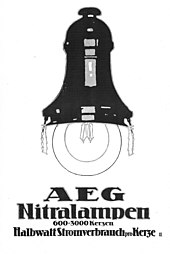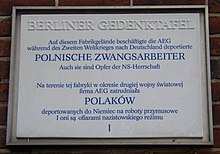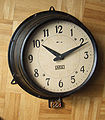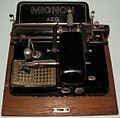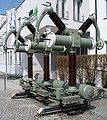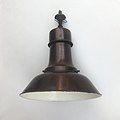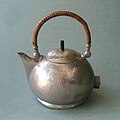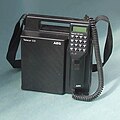AEG
| AEG Aktiengesellschaft
|
|
|---|---|
| legal form | Corporation |
| founding | 1883 as the German Edison Society for Applied Electricity |
| resolution | October 2, 1996 |
| Reason for dissolution | Merger with Daimler-Benz |
| Seat |
Berlin , Germany 1951 to 1996: Berlin and Frankfurt am Main |
| management | Ernst Stöckl (until 1996) |
| Number of employees | 11,000 (1995) |
| sales | 2.5 billion DM (1995) |
| Branch | Electrical engineering |
The AEG Aktiengesellschaft was one of the world's largest consumer electronics corporations . The company, which was founded in Berlin in 1883 as the German Edison Society for Applied Electricity and renamed Allgemeine Elektricitäts-Gesellschaft in 1888 , provided products for electrical energy technology and household needs (" white goods ") as well as devices for heating electrical buildings , trams , and electric and steam locomotives as well as motor vehicles in the subsidiary NAG .
The AEG group had to file for bankruptcy in 1982 and was taken over by Daimler-Benz AG in 1985 . Finally, in 1996, Daimler-Benz merged with its subsidiary, restructured parts of what was then the second largest German electrical company after Siemens, and parted with entire divisions.
With the end of the group after the merger in 1996, the AEG brand was licensed to Electrolux and other companies that had acquired parts of the company, and most recently sold to Electrolux, which issues licenses through its Electrolux Global Brand Licensing division . In the meantime, various manufacturers offer electrical goods in almost every category under the AEG brand , including music systems, car radios , chargers , household appliances, landline and mobile phones and sewing machines.
Before and during the First World War , AEG was the second largest arms manufacturer in the German Reich after Friedrich Krupp AG and built a. a. Aircraft for the air force of the German Army . With its participation in Deutsche Werft AG , founded in 1918, the group was involved in shipbuilding. In the 1930s, AEG engineers developed the magnetophone for recording sound on magnetic tape .
After the Second World War the seat was in Berlin and Frankfurt am Main . In 1967 AEG merged with its Berlin subsidiary Telefunken to form Allgemeine Elektricitäts-Gesellschaft AEG-Telefunken . In 1979 the company was changed to AEG-Telefunken Aktiengesellschaft . After the takeover by Daimler-Benz in 1985 and the outsourcing of all remaining Telefunken divisions, the name changed to AEG Aktiengesellschaft .
The box-shaped logo with the three letters in Antiqua was designed by Peter Behrens in 1912 .
Beginnings of the company
Edison company and a subsidiary
The company owes its establishment to Emil Rathenau , who in 1883 acquired the patents for Thomas Alva Edison's inventions on incandescent lamps for Germany and founded a small study society in Berlin, Schlegelstraße 26. In the same year this society became the German Edison Society for Applied Electricity.
The Edison Society founded the Städtische Elektricitätswerke (AGStEW) in Berlin in 1884 (from 1887: Berliner Elektricitäts-Werke ).
From 1883 to 1889, the Munich engineer and later founder of the German Museum Oskar von Miller was the director of the Edison Society.
First major products
Emil Rathenau brought Michail von Dolivo-Dobrowolsky into the company in 1887 , who, as chief engineer, helped three-phase technology to be used in practice by inventing the first functional three-phase motor . In 1891 Miller and Dobrovolski succeeded demonstrably at the International Electrotechnical Exhibition in Frankfurt am Main in the transmission of three-phase current over a longer distance: The electricity generated in a power station in Lauffen am Neckar was transported over the 175-kilometer three-phase transmission Lauffen-Frankfurt , where it was on the Exhibition grounds fed 1000 light bulbs and powered an artificial waterfall. This success marked the beginning of general electrification with alternating current in the German Reich and helped AEG to achieve economic success.
Factory buildings of the company
The first manufacturing facility was from 1886/1887 on Schlegelstraße 26/27 near the Szczecin train station . There, Emil Rathenau's German Edison Society began manufacturing incandescent lamps. In 1887, the Company acquired in Berlin-Gesundbrunnen the area between Ackerstraße , Field Street, Hermsdorf road (today's Max Urich Street) and Hussitenstrasse on which the previously Weddingsche Maschinenfabrik of William Wedding was. In 1887/1888 the master craftsmen H. Theleman and H. Büttner, C. Heidecke and the master builder A. Soeder carried out all the extensions.
AEG and other buildings in the north of Berlin
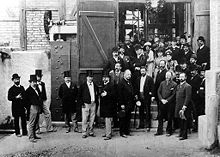
In 1888, in addition to a restructuring and expansion of the production range, the name was changed to Allgemeine Elektricitäts-Gesellschaft , AEG for short . Paul Tropp began his work for AEG from 1889/1890 to 1893, and Franz Schwechten designed the facades on Ackerstrasse and Hussitenstrasse around 1894/95. The five-story brick building encloses the area. In 1894 the area of the former Berlin cattle market between Hussitenstrasse and Brunnenstrasse was acquired. This also created a rail connection to the Berlin rail network, but a rail connection between the apparatus factory and the site of the former cattle market did not yet exist. In 1897, a subway was built in a specially constructed tunnel of 270 meters to connect the two properties. With its two above-ground terminus, the railway was only used for internal passenger and freight traffic. The tunnel construction was carried out under the direction of C. Schwebel and Wilhelm Lauter, who also planned the Spreetunnel Stralau , here for public transport.
At the urging of Kaiser Wilhelm II , AEG and Siemens & Halske founded the company for wireless telegraphy , System Telefunken, in equal parts with a share capital of 300,000 gold marks in Berlin on May 27, 1903.
Generous new buildings in the southeast of Berlin
In order to be able to realize the gradual expansion of the products, AEG settled from the 1910s mainly in Oberschöneweide, which had been quiet until then . The proximity to the Spree and the relocation of an industrial railway provided the best transport conditions there. With the participation of all well-known architects who had already designed buildings for AEG, numerous administration buildings and factory halls were now built there.
After the production facilities used by GDR companies from 1949 onwards were given up after 1990 , many buildings were empty. Over the past twenty years (as of 2018), however, the Berlin University of Applied Sciences and some start-ups have set up here.
A large hall built in 1910 at Reinbeckstrasse 12-38, which was named Spreehalle by the marketers , was renovated and generously expanded in 2017/2018. The Feilden Clegg Bradley Studios team of architects , not always in accordance with the preservation order, made steel and concrete fixtures and cut a courtyard into the hall. The converted building is intended to be used in the long term for various “post-industrial uses” such as studios. With the renovation work, the studio took part in the competition for the Prize of the Bund Deutscher Architekten 2018.
Product range (selection)
In 1907, AEG appointed the architect Peter Behrens as "artistic advisor". He was responsible for the design of all products, graphics, advertising materials and architecture and is therefore considered the world's first corporate designer . Product groups such as wall and factory clocks or kettles have become archetypes of modern industrial design . His designs tend to be reductive and contrast with the previously opulently decoratively designed things. In the case of consumer goods, such as lights, historicizing products continued to be offered, which date back to the time before Behrens' activity and which were sold in large numbers until the 1930s.
The company's activities soon extended to all areas of high-voltage engineering , in particular to lighting , electric motors , electric railways , electrochemical systems , and also the manufacture of steam turbines , diesel engines , automobiles , cables and line materials. In the first decades the company owned factories in and around Berlin:
- Machine factory ( dynamo machines , electric motors, transformers)
- Apparatus factory ( arc lamps , off switches, fuses, resistors, regulators, starters, measuring instruments of all kinds)
- Cable works (copper and metal works, rubber production, micanite factory)
- Incandescent lamp factories ( carbon filament and metal wire incandescent lamps , Nernst lamps ), transferred to Osram in 1920
- Turbine factory Moabit (steam turbines)
American influence from 1929
In 1929/1930 the US electrical and media company General Electric (GEC) took over AEG ordinary shares with a nominal value of 30 million Reichsmarks at a price of 200 percent , which corresponded to 27.5 percent of the share capital , and sent five members to the AEG supervisory board. At the general assembly of AEG on August 27, 1929, Hermann Bücher defended himself against the accusation of the shareholders that AEG was degenerating "into the chief salesman of General Electric in Europe", arguing that there were binding agreements that the GEC would never exceed 49% could acquire. This was greeted with laughter, because due to the fragmented share capital, the 27.5% is sufficient for control. On October 12, 1929, Carl Friedrich von Siemens alluded to GEC participation in a speech in the Reichstag , in which he stated: “Some leaders of the once so proud electrical engineering have given up the controls too early and the foreign pilots on board called because they did not believe they could master the storm themselves ”.
Company growth and National Socialism
- 1897: Acquisition of a large area in the then independent rural community of Oberschöneweide and construction of the two large companies Kabelwerk Oberspree (KWO) and Transformatorenwerk Oberspree (TRO) based on plans by the architects Peter Behrens and Ernst Ziesel .
- 1899: Production of Nernst lamps begins
- On October 10, 1899, AEG becomes a founding member of the study society for electric rapid transit trains in Berlin . The aim of the company is to gain practical experience with high speeds with electric traction .
- 1900: Invention of the hair dryer . In 1909, AEG secured the term Fön as a word and image trademark . Today the word and image trademark FOEN, registered in 1941, applies to AEG hair dryers and from 1978 to 2001 also the word mark TURBO FOEN .
- In 1901 the AEG subsidiary Neue Automobil-Gesellschaft AG (NAG) started manufacturing motor vehicles in the mechanical workshop of the Oberspree cable works in Oberschöneweide. In the not far away Ostendstrasse a new factory building (today's Peter-Behrens-Bau ) was built for NAG from 1914 to 1917 .
- 1903: The ongoing patent disputes with Siemens & Halske were settled through the establishment of the jointly operated "Gesellschaft für wireless Telegraphie mbH, System Telefunken ".
- 1904: Fusion of AEG and Union-Elektricitäts-Gesellschaft (UEG)
- 1906: The AEG house on Friedrich-Karl-Ufer 2/4 (from 1951: Kapelle-Ufer ) in Berlin-Mitte, designed by Alfred Messel , was moved into as the new corporate headquarters.
- 1910: Entry into aircraft construction with the aircraft construction department in Hennigsdorf near Berlin, construction of the Nieder Neuendorf factory airfield in 1912.
- Extension buildings on the site in Oberschöneweide, u. a. by AEG in-house architect Ernst Ziesel and civil engineer Gerhard Mensch

- 1915: Emil Rathenau, the AEG founder, died at the age of 76 from the consequences (including leg amputation) of his diabetes mellitus on June 20, 1915 in Berlin and his son Walther Rathenau took over the presidency of the AEG until his murder on June 24th. June 1922. In 1915 the AEG donated a new building to the Berlin Secession . Felix Deutsch took over the chairmanship of the board of directors of the AEG from 1915 and later the chairmanship of the board of the company until 1928 . From 1928 to 1947 Hermann Bücher led the AEG group. His deputy from 1930 to 1945 was Waldemar Petersen .
- 1916. Jan Czochralski discovered the possibility of producing single crystals in the AEG Berlin metal laboratory . Today 95% of the world production of single crystalline silicon is manufactured according to the Czochralski process.
- 1926: The group bought the property at Hoffmannstrasse 17-23 (since December 2010: Martin-Hoffmann-Strasse) in Berlin-Alt-Treptow and built the Apparate-Werke Treptow (AT) there according to plans by Ernst Ziesel , which in 1928 already had 4,000 people busy. Electrical switching devices, measuring instruments ( electricity meters ), radio receivers ( tube radios ) as well as relays and mercury vapor rectifiers were manufactured there. Only a few months before the end of the war, 80% of the works were destroyed, in 1948 the Apparate-Werke Treptow was renamed the Soviet Stock Corporation (SAG) and Elektro-Apparate-Werke Berlin-Treptow (EAW). After the transfer to GDR ownership, the EAW became VEB Elektro-Apparate-Werke Berlin-Treptow "Friedrich Ebert" in 1954 .
- 1927: The Berlin show and sales building at Luisenstrasse 35 was destroyed in a fire on September 15th.
- 1928: As a replacement, an area of 10,500 m² between Oranienburgerstrasse and Friedrichstrasse in the Friedrichstrasse Passage complex , which was completed in 1908 and which housed a Wertheim department store until 1914, was converted into a new showroom and retail store, which was called the House of Technology . There, in April 1939, the Reichspost set up Berlin's fourth “television intercom” at Friedrichstrasse 110–112 . (→ History of television in Germany ) The remains of the former AEG sales building were used between 1990 and 2012 as the arts center at Kunsthaus Tacheles .
- 1935: Presentation of the world's first tape recorder, Magnetophon K1, at the Great German Radio Exhibition in Berlin .
- In 1935 the Borsig Lokomotiv-Werke were taken over, the locomotive construction of which was then relocated to Hennigsdorf .
- 1938: After ceasing its automobile production, AEG set up the Oberspree tube factory (RFO) in the former NAG building in Ostendstrasse . a. special electron tubes for the GEMA in Koepenick developed radars of the Armed Forces created. The Soviet Military Administration in Germany (SMAD) founded the Labor, Design Office and Experimental Plant Oberspree (LKVO) there in July 1945 , which from May 1946 on was called Oberspreewerk (OSW). The company, renamed in July 1951 as Plant for Telecommunications (HF), became the RFT Plant for Television Electronics (WF) in 1960 .
In 1940 an agreement was reached with Siemens & Halske, and mutual interrelationships were largely dissolved. The Osram joint venture joined Siemens and the Telefunken joint venture joined AEG. Siemens & Halske received permission to continue using the Telefunken patents until the end of the war.
From 1939, the AEG used forced labor in Berlin. They came u. a. from Belgium, Denmark, France, the Netherlands, Poland and the Soviet Union. In 1942 the group employed 175,000 people, of which forced labor made up 35 percent and in some departments up to 60 percent. From 1942/43, concentration camp prisoners were increasingly deployed at AEG. A satellite camp of the Sachsenhausen concentration camp was set up at the AEG in Berlin-Köpenick.
Building (selection)
Incandescent lamp factory Berlin-Moabit, Sickingenstr. 70/71, built 1907–12
From 1920: Osram-Werk A (like AEG); from 1939: Telefunken; since 2005: Jobcenter Berlin-Mitte
1945 to the late 1960s
After the Second World War , the corporate headquarters, the AEG-Haus on Friedrich-Karl-Ufer, was almost completely destroyed and was also located in the Soviet sector of Berlin. The plant in Hennigsdorf was confiscated by the Soviet military administration in Germany (SMAD) and in 1948 it was transferred to VEB Lokomotivbau Elektrotechnische Werke Hennigsdorf (LEW). Likewise, the Oberspree cable works (KWO), the Oberspree transformer works (TRO) in Berlin-Oberschöneweide and the Treptow apparatus factory initially became Soviet joint-stock companies (SAG) and later also VEB. The reconstruction of the group could not be managed from the now divided city , also because of the Berlin blockade that began in mid-1948 . The management for the non-expropriated parts of the company was therefore initially relocated to Hamburg .
In Berlin-Schmargendorf , a branch for various business areas and a sales office was set up at Hohenzollerndamm 150–152 in the extensive building complex of the former military district command III of the Wehrmacht from 1948/1950. With the loss of KWO and TRO at the largest location in Oberschöneweide, cable production at AEG was completely discontinued and the construction of power transformers was set up in Brunnenstrasse (Berlin-Wedding district) . Following the resumption of production in West Berlin , Nuremberg (home appliances), Stuttgart (Power Tools) and Mülheim an der Ruhr emerged (repair shop for high-voltage transformers) in West Germany new works, among others, from May 1946, the meter factory in Hameln , which later breakers and technical lights and in 1963 employed around 2,500 people. Many of the new factories, such as the Olympia office machine works that were relocated from Erfurt , were initially set up in former Wehrmacht properties, which, however, were only conditionally suitable for production and permanently put AEG at a competitive disadvantage.
- 1948: The AEG factory in Kassel (FK) at Lilienthalstrasse 150 was put into operation in the halls of the former MWK ( engine construction plant Kassel ). The first part of the factory was the high-voltage switchgear factory (HSF), followed later by cooling device production (KSF), ticket printer factory (FDF), insulating material factory (IF) and the globally recognized high-voltage institute (HI). In the early 1960s, more than 5000 employees worked in the various areas of the Kassel plant.
- 1951: The AEG high-rise on Theodor-Stern-Kai in Frankfurt am Main was used as the new company headquarters. The factory in Oldenburg (Oldb.) Produced small engines and household appliances and in 1963 employed around 2,650 people. The number of employees in the group rose from 20,900 in September 1948 to 55,400 in September 1957. In the same year, sales exceeded one billion DM for the first time. The high investments for rebuilding AEG (from 1948 to 1956 over 500 million DM) were a burden however, the balance sheet is considerable.
- 1958: The company presented its first fully automatic washing machine , the “Lavamat” . In advertising for AEG Hausgeräte the first time slogan AEG - A us E xperience G ut used, from which the vernacular soon " A verything E in G Ammel - A via e s G eht" makes or: " A uspacken, E inschalten, G arantiefall or G not eht "or East Frankish :" A llmächd, e dz G äihds "or" A lt e isen- G SOCIETY ".
- In 1960 the Telefunken high-rise was built in Berlin as the headquarters of the AEG subsidiary Telefunken . After the merger of the two companies to AEG-Telefunken AG, it continued to be used by this and finally to the 1975 Berlin Senate sold it the TU Berlin left.
- 1962: The AEG group had 127,000 employees in the Federal Republic of Germany and achieved an annual turnover of 3.1 billion DM. In Springe , AEG opened a new factory for the production of regulating and control devices with 200 employees in February 1962.
- 1962: Patent granted for the PAL color television system developed by Walter Bruch at Telefunken in Hanover .
- 1965: The first optoelectronic fiber optic system was invented by Manfred Börner in 1965 . He designed a long-range optical transmission system that combined laser diodes , glass fibers and photodiodes . In 1966 he applied for a patent for the system for AEG- Telefunken . All optical long-distance transmission systems still work today according to this system principle proposed by Manfred Börner. For his invention, Börner was awarded the Eduard Rhein Prize in 1990.
- 1966: In Berlin, the largest machine hall was completed on the Brunnenstrasse area in the Wedding district . At that time it was considered the largest hall in the industry in Europe (175 m long, 45 m wide and 26 m high) and, with its four connectable crane runways, allowed the construction of motors and generators of the highest performance and individual weights of up to 400 t for the world market. The then US Attorney General Robert F. Kennedy was present at the laying of the foundation stone . The hall was demolished in 1986 after the Brunnenstrasse plant was closed. Siemens Nixdorf erected new buildings on Brunnenstrasse which are no longer there today.
- January 1, 1967: Merger with Telefunken to form: Allgemeine Elektricitäts-Gesellschaft AEG-Telefunken , based in Frankfurt am Main. Takeover of Linde Household Appliances GmbH from Linde AG .
Decline and loss of independence
- 1970: Worldwide, AEG-Telefunken was twelfth in the world ranking of the largest electrical companies with 178,000 employees. However, the corporate crisis loomed. The company was burdened , among other things, by ultimately unsuccessful projects such as the construction of an automatic baggage handling system at Frankfurt am Main Airport and the start of the construction of nuclear power plants . The construction line of boiling water reactors developed by AEG in the 1960s could not establish itself on the market. In particular, the Würgassen nuclear power plant , whose commissioning was delayed for years due to a number of technical problems, cost AEG hundreds of millions of marks . In addition to such technical problems, a major cause of the collapse was chaotic finance and planning. Planning documents were unnecessarily detailed and therefore incomprehensible. In Frankfurt there was a bloated, ineffective corporate headquarters with almost 1,000 employees. Gains and losses from various business areas were combined by accounting in such a way that, according to insider information, not a single area showed actual profits. AEG was not alone with such problems (see also the sinking of Borgward and Vulkan shipyard ).
- 1972: The group paid a dividend for the last time. The entertainment electronics was outsourced under the name Telefunken TV and radio GmbH with headquarters in Hanover. Computer technology followed: The mainframe area of activity ( TR 4 , TR 10, TR 440 ) was initially brought into a cooperation under the name Telefunken Computer GmbH with the company Nixdorf Computer and two years later it was sold to Siemens ( Computer Gesellschaft Konstanz ). The field of activity of process computers (TR 84, TR 86, AEG 60-10, AEG 80-20, AEG 80-60) was continued in the automation technology division (from 1980 as ATM Computer GmbH).
- 1975: The former Telefunken skyscraper on Berlin's Ernst-Reuter-Platz was sold to the Berlin Senate . The building had previously been rented to the TU Berlin .
- 1976: In order to circumvent the equal participation of employees on the supervisory board as stipulated in the new Codetermination Act , the new AEG CEO Walter Cipa - the doctor of geology came from Gelsenkirchener Bergwerks-AG and was AEG boss until the end of January 1980 - alongside the two self-employed company AEG Hausgeräte GmbH and Telefunken television and radio GmbH founded four additional "operating companies" with the legal form of an AG that were 100 percent subsidiary companies of the parent company (the numbers in brackets refer to the share of Group sales in 1980):
- AEG-Telefunken Anlagentechnik AG (37%)
- AEG-Telefunken Series Products AG (16%)
- AEG-Telefunken Kommunikationstechnik AG (6%)
- Olympia-Werke AG (office technology division, 7%)
- AEG-Hausgeräte GmbH (22%)
- Telefunken TV and Radio GmbH (12%)
- 1979 was elimination of the originating still from 1887 additional designation General Electric Company , the company from EC legal reasons AEG-Telefunken Aktiengesellschaft changed.
- 1980: Heinz Dürr became CEO on February 1 (until 1990)

- 1982: On August 9, the group management had to file a settlement at the Frankfurt am Main district court . A restructuring plan, which provided for federal guarantees of 600 million DM and new bank loans of 275 million DM, initially failed due to the disagreement between the banks, then a bank consortium granted the AEG Group an administrator loan of 1.1 billion DM until June 1983 700 million DM were immediately available and 400 million DM after a guarantee by the federal government. The settlement administrator was the lawyer Wilhelm Schaaf. As a result of the AEG's settlement procedure (August 1982 to October 1984), other essential core areas were transferred. This affected not only AEG-Telefunken AG, but also the subsidiaries Küppersbusch AG in Gelsenkirchen , Hermann Zanker Maschinenfabrik GmbH & Co. KG in Tübingen and Carl Neff GmbH in Bretten. The Alno Möbelwerke GmbH & Co. KG in Pfullendorf was again taken over by the former minority shareholders of Nothdurft family and spun off from the Group. AEG suppliers also had to file for bankruptcy. a. the Cups & Co. KG Furniture factories in Bühlertann. This was partly triggered by inappropriate company acquisitions and a lack of continuity in corporate policy. One of the effects of the comparison was the sale of the area of the traditional machine factory in Brunnenstrasse in what was then Berlin's Wedding district . The large and small machine factory was thus given up in favor of the Lloyd Dynamowerke in Bremen (medium-sized machines ), the AEG-Fabrik Essen (large machines) and the Bauknecht company (small machines). New factories were built in Berlin-Marienfelde and Berlin-Spandau for the converter factory and the railway factory, which are also located on this site . The main computer center and the Institute for Automation were housed at different locations.
- 1983/1984: The entertainment electronics division ( Telefunken TV and Rundfunk GmbH ) was sold to the French state group Thomson-Brandt , which subsequently merged production with SABA and Nordmende .
As part of Daimler-Benz AG
- 1985: Takeover by Daimler-Benz AG . The name was again AEG Aktiengesellschaft , logo see above. This should better represent the vision of the Daimler-Benz board member Edzard Reuter (from 1987 Daimler-Benz board chairman), who wanted to create an "integrated technology group" out of both companies. As part of this takeover, parts of AEG were outsourced to the sister company DASA .
- 1988: On the occasion of the celebration of the 60th anniversary of the AEG Research Institute, AEG donated the Carl Ramsauer Prize .
- In 1990 the rail sector cooperated briefly as AEG Westinghouse Transport-Systeme GmbH (based in Berlin) with Westinghouse Transportation Systems Inc. in Pittsburgh , USA.
- 1992: Merger of the railway division with the Lokomotivbau Elektrotechnische Werke Hennigsdorf , from which the "AEG rail vehicles GmbH" emerged.
- 1992: The Swedish Atlas Copco group acquired AEG Elektrowerkzeuge GmbH.
- 1994: Sale of the automation technology department ( Modicon ) to Schneider Electric and AEG Hausgeräte GmbH to Electrolux .
- 1995: The AEG rolling GmbH moved to the relocation of Spandau establishment of Hennigsdorf in the ABB Daimler-Benz Transportation (Adtranz) and with that on 1 May 2001 in the Bombardier Transportation over, but remained under HRB 2889 with the registration court Potsdam based registered in Hennigsdorf (as of August 2020).
- 1996:
- Sale of nine medium-sized companies to Elexis Elektroholding GmbH (renamed elexis AG in 1998 ).
- Takeover of AEG plant and automation technology by Cegelec .
- Takeover of AEG Energietechnik (AEG T&D, Transmission and Distribution) by GEC- Alsthom
- By resolution of the general meeting of Daimler-Benz AG chaired by Jürgen Schrempp , the lossy group merged with Daimler-Benz AG. Newly founded companies or existing ones (e.g. DASA ) should continue various business areas of the former AEG group.
- October 2, 1996: After more than 113 years of company history was company AEG Aktiengesellschaft in the commercial register deleted from Frankfurt.
CEO of AEG
| Surname | From | To |
|---|---|---|
| Emil Rathenau | 1887 | 1915 |
| Felix German | 1915 | 1928 |
| Hermann books | 1928 | January 1946 |
| Walther Bernhard | January 1946 | May 1947 |
| Friedrich Spennrath | May 1947 | December 1955 |
| Hans C. Boden | January 1956 | February 1961 |
| Hugo Bäurle (1912–1962) |
March 1961 | January 1962 |
| Hans C. Boden | February 1962 | September 1962 |
| Hans Heyne | October 1962 | December 1964 |
| Berthold Gamer | January 1965 | December 1965 |
|
Hans Bühler (1903–1997) |
January 1966 | June 1970 |
| Hans Groebe | June 1970 | July 1976 |
| Walter Cipa | July 1976 | January 1980 |
| Heinz Dürr | February 1980 | December 1990 |
| Ernst Georg Stoeckl | January 1991 | September 1996 |
Afterlife
Parts of the group become companies that license the brand
With the liquidation of AEG in 1997, the company archive in Frankfurt was dissolved and handed over to the German Museum of Technology in Berlin . In 1999 the AEG high-rise that had been sold to Allianz was demolished, which had a new office and service center built there with the " Allianz -Kai".
The trademark rights were transferred to the new group subsidiary EHG Elektroholding GmbH of DaimlerChrysler AG , which managed the AEG brand in Frankfurt and licensed it to former group subsidiaries.
- 2000:
- AEG Softwaretechnik, founded in 1981, part of the repas AEG group of companies since 1996 and under the name repas AEG Software GmbH since 1998, was taken over by PSI AG in 2000 and traded as PSI Transportation GmbH, and since 2007 as PSI Transcom GmbH. The AEG part of the name disappeared. The PSI AG was founded in 1969 by AEG employees.
- 2002:
- Closure of the AEG home appliance factory in Kassel- Bettenhausen , relocation of the production of refrigerators and freezers to Italy and Hungary .
- The Stiebel-Eltron Group buys Electrolux Haustechnik GmbH (EHT) with AEG Haustechnik.
Sale of the brand to Electrolux, licensing to third-party companies for various consumer goods
In 2004, EHG Elektroholding GmbH sold the global AEG trademark rights to the Swedish Electrolux AG for a number of product groups .
Electrolux had already taken over the home appliance division earlier. Now the brand was given to third companies that labeled consumer goods with the name of the former group. B. Clatronic (ETV Elektrotechnische Vertriebsgesellschaft mbH) for entertainment electronics and "Health Care". In 2011 a brand license for LED lamps was granted to Elec Tech International from Hong Kong.
Further history of former parts of the group
- 2005: acquisition of the electric machine AEG brand of Atlas Copco by Techtronic Industries , which since then under the name of A & M Electric Tools operates.
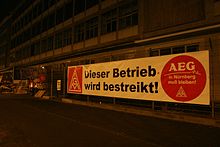
- 2005: Announcement of the closure of the AEG plant in Nuremberg and relocation of production to Poland and Italy. In future, all AEG household appliances, with the exception of the ovens, stoves and hobs produced at the AEG plant in Rothenburg ob der Tauber, will be produced outside Germany (primarily in Poland, Hungary and Italy). The closure led to a six-week strike by the workforce and a boycott call by the union ( consumer boycott ).
- 2007: The last AEG washing machine rolled off the assembly line in the Electrolux plant in Nuremberg on March 9; the factory was closed on March 16.
- 2008: Electrolux reactivated the entrepreneurial shell in August 2008, so that the name AEG appeared as a new part of the group.
- In 2009, the Special Purpose Acquisition Company (SPAC) Germany1 Acquisition Limited acquired the majority in the manufacturer of power supply devices AEG Power Solutions from the financial investor Ripplewood . AEG Power Solutions, based in the Netherlands, emerged from Saft Power Systems (formerly a subsidiary of Alcatel ), which acquired AEG SVS Power Supply Systems GmbH in 1998 ; since 2008 the group has been operating under the name AEG Power Solutions . The listed 3W Power SA with headquarters in Luxembourg is the holding company of the AEG Power Solutions Group (as of December 2014).
- AEG capacitors and converters GmbH
In 1996 the AEG capacitors and converters GmbH (AEG KUW GmbH) was founded in Berlin . The company goes back to Hydrawerk AG , which has existed since 1899 in Drontheimer Straße, Gesundbrunnen (formerly Wedding district ) , which produced capacitors and dry rectifiers . From the 1940s onwards, AEG owned all of the shares in Hydrawerk AG. In 1996, after the dissolution of AEG, this went to the British Elexis and remained a leading manufacturer of MP capacitors for household appliances. At the end of 1998, AEG KUW GmbH was sold to Berlin-based KuW Condensers and Wandler Beteiligungs GmbH , a company former managers of AEG KWU GmbH. AEG KUW GmbH was involved in a takeover scandal of a capacitor factory in Slovenia between 2000 and 2002 . As a result, there were allegations of deliberate deception and mismanagement, so that the company in Semič was deliberately driven into bankruptcy. This was finally taken over by the banking group Hypo Alpe Adria and has been back in Slovenian ownership since then. In 2002 AEG KWU GmbH stopped the production and sale of capacitors. The delivery program was taken over by Epcos AG. In March 2003, Maschinenfabrik Reinhausen (MR) announced the takeover of AEG KWU GmbH.
Production areas
Automobile manufacturing
The NAG ( Neue Automobil-Gesellschaft ) was responsible for motor vehicle production . She initially built her first car at the AEG cable factory in Oberspree, based on designs by Georg Klingenberg . Later designs came from Josef Vollmer . In 1903 the construction of trucks began. In 1915, during the First World War , the company was changed to Nationale Automobil-Gesellschaft AG out of patriotism . In 1917, NAG moved into its new factory in the “ Behrensbau ” in Oberschöneweide, Ostendstrasse 1-4. From 1904 to 1934 a total of 23 different NAG car models came onto the market.
Office and energy technology
Turbines in the Vemork hydroelectric power station (around 1911)
High Voltage Circuit Breaker (1970)
Aircraft construction
In 1910 the aircraft construction started with the "AEG, Aircraft Construction Department" in Hennigsdorf near Berlin. There is a pure timber along the lines of 1912 was the first aircraft biplane the Wright brothers built. It had a wingspan of 17.5 m and an eight-cylinder engine with 75 hp as a drive . The curb weight of the aircraft was 850 kg; the speed reached 65 km / h. From 1912 onwards, the aircraft were built using a composite construction of wood and tubular steel with fabric covering.
During World War I, AEG built 658 C aircraft and 523 G aircraft. Messrs. Stumpf and König were the designers.
During the Second World War, the AEG helicopter powered by a three-phase motor was developed for reconnaissance purposes ; the power was supplied by cables from the ground, so the platform is “tied up”, it cannot fly freely. Only about 800 m altitude was reached.
Household technology and lighting
Radio and phono technology
Rail vehicle construction
As a founding member of the study society for electrical rapid transit systems , AEG, together with Siemens & Halske, was in charge of the further development of electrical traction and rapid rail vehicle transport as early as 1899. As a highlight, on October 28, 1903 , on the test route of the Royal Prussian Military Railway between Marienfelde and Zossen , a three-phase motor vehicle built by AEG at 210 km / h set a speed record for rail vehicles that had existed for over 30 years.
From the completion of the Prussian ES 2 in 1911, AEG was involved in the development and manufacture of the electrical part of several electric traction vehicles in Germany until the end of the 20th century. In addition, steam locomotives and benzene railcars were built in the AEG works .
In 1931 AEG took over the locomotive construction of the Berlin Borsig works and transferred the entire locomotive construction to the works in Hennigsdorf (as a subsidiary of Borsig Lokomotiv-Werke GmbH), in 1936 the Wildau works were added. After the end of the war , the Hennigsdorf plant, which was now part of the GDR , became the VEB Lokomotivbau Elektrotechnische Werke "Hans Beimler" Hennigsdorf (LEW), and the Wildau plant became the "LOWA Lokomotivbau Wildau VEB" . In addition to the steam locomotive construction, which continued to a small extent until 1954, electric locomotives were built there for the Deutsche Reichsbahn and abroad.
From 1972 by AEG in a consortium with BBC and Siemens , the magnetic levitation for vehicles according to the system of electrodynamic levitation explored (EDS). The first successes were seen on the Erlangen circuit , with the Erlangen test vehicle EET 01 supplied by MAN . In contrast to the competing system of electromagnetic levitation (EMS), however, this did not lead to further developments and commercial application. Based on this, the M-Bahn was planned together with the TU Braunschweig and the Berliner Verkehrsbetriebe (BVG) and a demonstration line was installed in Berlin, which was operated between 1989 and 1991. A linear motor was used as the drive, while strong permanent magnets under the cabin carried 85 percent of the vehicle's weight. The guidance and support took place both horizontally and vertically with small wheels.
E 60 10
AEG test vehicle 182 001
M-Bahn in the Nuremberg Transport Museum
In the development of three-phase current generation by means of traction converters for locomotive drives , AEG in Germany fell behind its competitor BBC in the 1970s. The knowledge gained through the three-phase test vehicle 182 001 from 1981 onwards, however, led to orders for the series production of three-phase technology in the 120 and 401 series (ICE 1) . Only after German reunification and the takeover of the LEW works in Hennigsdorf did AEG return to locomotive production on a larger scale for a short time. In 1990 AEG took over MAN Gutehoffnungshütte Eisenbahnverkehrstechnik AG in Nuremberg . This was renamed in 1993 to AEG rail vehicles Nahverkehr & Wagen GmbH . In 1995, AEG rail vehicles GmbH was converted into ABB Daimler-Benz Transportation (Adtranz, today Bombardier Transportation ).
Projectors
AEG also produced film projectors for a longer period of time .
- 1919: Standstill machine, 35 mm projector
- 1920: theater machine, 35 mm projector
- 1924–1935: Triumphator I – III, 35 mm projector ACR 0710
- 1925–1935: Successor (teacher), 35 mm projector
- 1927: Case cinema encased, 35 mm projector
- 1929: Teacher, 35 mm projector ACR 0709 (Leitz)
- 1929–1934: Mechau Model 4, 35 mm projector
- 1938–1942: Euro K, 35 mm projector
- 1936: Euro M, 35 mm projector
- 1938: Euro G, projector 35 mm, interlock version (G-MB)
- 1939–1944: Euro M2, 35 mm projector
literature
- Peter Strunk: The AEG. The rise and fall of an industrial legend. Nicolai, Berlin 1999, ISBN 3-87584-863-2 .
- Erdmann Thiele (Ed.): Telefunken after 100 years - the legacy of a German global brand. Nicolaische Verlagsbuchhandlung, Berlin 2003, ISBN 3-87584-961-2 .
- 50 years of AEG. printed as a manuscript. General Electricity Society Press Department , Berlin 1956, OCLC 68693563 .
- Manfred Pohl : Emil Rathenau and the AEG. AEG Aktiengesellschaft, Berlin / Frankfurt am Main 1988, ISBN 3-7758-1190-7 .
- From the history of AEG: 25 years ago: Construction of the first AEG aircraft. In: AEG communications. Born 1937, issue 10 (October), pp. 359–362.
- Miron Mislin : Industrial architecture in Berlin 1840–1910. Wasmuth Verlag, Tübingen 2002, ISBN 3-8030-0617-1 , pp. 388-403.
- Peter Obst: Die Industrie am Humboldthain (machine factory), AEG 1896–1984. Berlin Management Innovation Center (IZBM).
- S. Müller, K. Wittig, S. Hoffmann: Empirical findings on the consumer boycott. The AEG / Electrolux case. Dresden Contributions to Business Administration No. 116/06, 2006. (more on this) ( Memento from July 19, 2011 in the Internet Archive )
- Hans-Heinrich von Fersen: Cars in Germany 1920–1939.
- Gert Hautsch: The AEG-Telefunken empire, a multinational corporation. Frankfurt am Main 1979.
- Felix Pinner: Emil Rathenau and the electric age. Academic Publishing Company, Leipzig 1918, DNB 362043442 .
- Harri Czepuck: A symbol breaks, on the history and politics of AEG. Dietz Verlag, Berlin 1983, DNB 830767525 .
- Tilmann Buddensieg: Peter Behrens and AEG, New Documents on the Building History of the Factories at Humboldthain. In: Charlottenburg Palace Berlin-Prussia. Deutscher Kunstverlag, Munich 1971.
- Annual rings Association for early retirement and active age, Land Brandenburg e. V. (Ed.): Contemporary witnesses 1945–1990. Part I (1999) and II (2000).
- Lieselotte Kugler, Kerstin Lange: AEG in the picture. Nicolaische Verlagsbuchhandlung, Berlin 2000
- Thomas Irmer: A factory foundation for women - On the history of the "Mathilde-Rathenau-Stiftung" for female employees of the "Allgemeine Elektricitäts-Gesellschaft" (AEG) 1892-1933. In: Andreas Ludwig, Kurt Schilde (ed.): Jewish welfare foundations. Fachhochschulverlag, Frankfurt am Main 2010, pp. 213–237.
- Thomas Irmer: Forced Labor for the German Electrical Industry in Occupied Poland - The »Allgemeine Elektrizitäts-Gesellschaft« (AEG) and the Kraków Cable Works 1941–1944. In: Andreas Heusler, Mark Spoerer, Helmuth Trischler (eds.): Armaments, war economy and forced labor in the »Third Reich«. (= Perspektiven. Series of publications by the BMW Group - Corporate Archives, Vol. 3), R. Oldenbourg, Munich 2010, ISBN 978-3-486-58858-3 , pp. 87-105.
- Thomas Irmer: "Allmand cochon" - Resistant behavior of foreign forced laborers using the example of AEG / Telefunken in Berlin. In: Hans Coppi, Stefan Heinz (ed.): The forgotten resistance of the workers. Trade unionists, communists, social democrats, Trotskyists, anarchists and forced laborers. Karl-Dietz-Verlag, Berlin 2012, ISBN 978-3-320-02264-8 , pp. 248-262.
- Jesko Dahlmann: Innovative entrepreneurship in the sense of Schumpeter: theory and economic history. Metropolis Verlag, Marburg 2017, ISBN 3-7316-1313-1 , pp. 141–191.
Web links
- www.aeg.de website operated by Electrolux Global Brand Licensing (owner of the trademark rights)
- Extensive website of a former employee on the company's history on gerdflaig.de
- Early documents and newspaper articles on AEG in the 20th century press kit of the ZBW - Leibniz Information Center for Economics .
- The rise and fall of the AEG: Only the three letters survived on Heise online
- History of the AEG , twelve-minute video documentation on YouTube
- 1912 plan of the AEG-Fabriken Brunnenstrasse
Individual evidence
- ^ Economy: AEG: emaciated electrical company. on: focus.de , November 6, 1995.
- ↑ a b c Entry 11/14/1984: Hessen AG FFM: HRB 25000: AEG Aktiengesellschaft, Frankfurt am Main (history 1. AEG-TELEFUNKEN AKTIENGESELLSCHAFT); Deletion date: 11/14/1984: Hessen AG FFM: HRB 8060: AEG-TELEFUNKEN AKTIENGESELLSCHAFT, Berlin and Frankfurt am Main
- ↑ Spelling with c see: - AEG partial debenture from 1962 ( Memento from September 12, 2015 in the Internet Archive )
- ^ "Even giants can die" by Richard Gaul at Zeit.de: "the greatest bankruptcy of the post-war period".
- ↑ www.aeg.com ( Memento from November 30, 2012 in the Internet Archive )
- ↑ Information in the register of the German Patent and Trademark Office.
- ^ Letters Museum , accessed on July 21, 2013
- ↑ AEG. The small chronology at sdtb.de, accessed on June 19, 2015
- ^ Electric subway in Berlin. Opening of the AEG tunnel line between the factory site in Brunnenstrasse and Ackerstrasse. In: Elektrotechnische Zeitschrift, 1897, p. 339.
- ^ Nikolaus Bernau: Brave new world of work . In: Berliner Zeitung , September 20, 2018, p. 10.
- ↑ Clemens Verenkotte : The fragile alliance. American bonds and German industry 1924–1934 . Freiburg 1991, p. 295.
- ↑ Eberhard Koebel-Tusk: AEG Energy - Profit - Crime . Berlin 1958, p. 114.
-
↑
Information on the Foen brand - word and figurative mark 1941 in the register of the German Patent and Trademark Office (DPMA)
information on the TURBO FOEN trademark - word mark 1978–2001 in the register of the German Patent and Trademark Office (DPMA) - ↑ Oberschöneweide at a glance. On berlin.de, accessed on May 21, 2012 ( Memento from May 30, 2014 in the Internet Archive )
- ↑ Tanja von Fransecky: Forced Labor in the Berlin Metal Industry 1939 to 1945. Otto Brenner Foundation, March 2003, accessed on August 17, 2019 .
- ↑ Forced Labor under National Socialism - History at a Glance. Berlin History Workshop, accessed on August 17, 2019 .
- ↑ Susanne Eckelmann / Cord Pagenstecher: For an introduction . Ed .: Berlin History Workshop. 2000, p. 8 .
- ^ Hans-Liudger Dienel: Die Linde AG: History of a technology group 1879-2004 , page 239
- ^ Niels Beisinghoff: repas AEG Company Description. 1998, accessed January 3, 2020 .
- ↑ The history of AEG , accessed on October 26, 2015
- ↑ Clatronic partner project TiLO . University Duisburg-Essen. Archived from the original on October 1, 2012. Retrieved on March 8, 2012.
- ^ Electrolux Global Brand Licensing expand in the Green Energy sector by signing LED light contract ETI, December 20, 2011
- ↑ Germany2 goes public without Middelhoff. 5 September 2009, on: wiwo.de .
- ↑ Exchange envelope with Berger and Middelhoff. June 30, 2008 on manager-magazin.de
- ^ Owner Beteiligungs GmbH: Sale of AEG capacitors . In: Berliner Zeitung . ( berliner-zeitung.de [accessed on August 18, 2017]).
- ↑ Dieter Wuschick: AEG capacitors expand to the east Die Welt, June 14, 2000
- ↑ Press release from EPCOS ( Memento from April 12, 2013 in the web archive archive.today ), April 4, 2002
- ↑ Christine Schwaiger: News - MR takes over AEG division. Retrieved August 18, 2017 .
- ^ History of German truck construction. Volume 1, Weltbild, 1994, OCLC 312327605 , pp. 126-131.
- ↑ Kroschel, Stützer: The German military aircraft 1910–1918. Verlag ES Mittler & Sohn, ISBN 3-89350-693-4
- ↑ Rolf Löttgers: The narrow-gauge railway time in color . Franckh'sche Verlagsbuchhandlung, Stuttgart 1983, ISBN 3-440-05235-4 , p. 80 .
- ↑ Magnetic levitation train Transrapid - flying at zero altitude in Germany. Retrieved August 18, 2017 .
- ↑ Kurt Enz : 100 Years of German Film Projectors. Manuscript printing. Berlin 1996, p. 14 ff.







